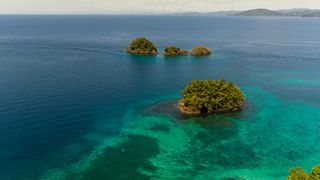Researchers have spotted an atypical gathering of rare prickly sharks around a seamount off Panama.

Rarely-seen deep-sea sharks have been spotted mysteriously gathering off a seamount near Panama — the first time the species has ever been documented in the area.
In a study published March 8 in the Journal of Fish Biology, scientists confirmed the “atypical” gathering of 12 prickly sharks (Echinorhinus cookei) in the Cordillera de Coiba, Pacific Panama — a 26,000-square-mile (68,000 square kilometers) offshore marine protected area that includes nine mountain ranges, 24 seamounts and a 15,568-foot-deep (4,745 meters) trench.
The elusive prickly sharks, which have bodies covered by thorny, modified teeth, grow up to to 13 feet (4 m) long and may inhabit depths of up to 3,280 feet (1,000 m). “They prefer to be in deeper waters,” which makes them difficult to observe, study author Héctor Guzmán, a marine ecologist at Smithsonian Tropical Research Institute, told Live Science. Although information on the distribution of this species is scarce, they have been observed from Oregon and Japan in their northerly range down to Chile and New Zealand.
Scientists believe these gatherings, which took place in May 2022 between 495 and 1,146 feet (151 to 350 m) deep, were “deliberate.” . Before this discovery, there had been no evidence that these sharks aggregated. The researchers aren’t sure why the sharks were coming together, but it could be to do with feeding. “We saw juvenile hammerheads down there and those are easy targets for the prickly,” Guzmán said. It could also be linked to reproduction. The team checked the sharks’ claspers — modified pelvic fins used in reproduction — to confirm that both male and female sharks were at the gatherings.
Related: Watch a super-rare dreamer anglerfish with ultra-black ‘invisibility cloak’ swim like a shadow in the deep sea

The researchers observed the gatherings as they explored two seamounts on the Cordillera de Coiba, not far from Colombian waters, during 11 dives in a three-person submersible — with a camera and robotic arm to collect samples.
Confirming the presence of prickly sharks around these seamounts is important for the conservation of these biodiversity hotspots. “It helps us to justify why we’re protecting these highly productive systems,” Guzmán said, because focusing on protecting the whole habitat would, in turn, help all the species that use it.
window.sliceComponents = window.sliceComponents || {};
externalsScriptLoaded.then(() => {
window.reliablePageLoad.then(() => {
var componentContainer = document.querySelector(“#slice-container-newsletterForm-articleInbodyContent-UDvjH6GXFbivthHWLWBd37”);
if (componentContainer) {
var data = {“layout”:”inbodyContent”,”header”:”Sign up for the Live Science daily newsletter now”,”tagline”:”Get the worldu2019s most fascinating discoveries delivered straight to your inbox.”,”formFooterText”:”By submitting your information you agree to the Terms & Conditions and Privacy Policy and are aged 16 or over.”,”successMessage”:{“body”:”Thank you for signing up. You will receive a confirmation email shortly.”},”failureMessage”:”There was a problem. Please refresh the page and try again.”,”method”:”POST”,”inputs”:[{“type”:”hidden”,”name”:”NAME”},{“type”:”email”,”name”:”MAIL”,”placeholder”:”Your Email Address”,”required”:true},{“type”:”hidden”,”name”:”NEWSLETTER_CODE”,”value”:”XLS-D”},{“type”:”hidden”,”name”:”LANG”,”value”:”EN”},{“type”:”hidden”,”name”:”SOURCE”,”value”:”60″},{“type”:”hidden”,”name”:”COUNTRY”},{“type”:”checkbox”,”name”:”CONTACT_OTHER_BRANDS”,”label”:{“text”:”Contact me with news and offers from other Future brands”}},{“type”:”checkbox”,”name”:”CONTACT_PARTNERS”,”label”:{“text”:”Receive email from us on behalf of our trusted partners or sponsors”}},{“type”:”submit”,”value”:”Sign me up”,”required”:true}],”endpoint”:”https://newsletter-subscribe.futureplc.com/v2/submission/submit”,”analytics”:[{“analyticsType”:”widgetViewed”}],”ariaLabels”:{}};
var triggerHydrate = function() {
window.sliceComponents.newsletterForm.hydrate(data, componentContainer);
}
if (window.lazyObserveElement) {
window.lazyObserveElement(componentContainer, triggerHydrate);
} else {
triggerHydrate();
}
}
}).catch(err => console.log(‘Hydration Script has failed for newsletterForm-articleInbodyContent-UDvjH6GXFbivthHWLWBd37 Slice’, err));
}).catch(err => console.log(‘Externals script failed to load’, err));
But although the seamount is located inside a no-take zone — where no fishing is allowed — the researchers saw a Colombian vessel illegally fishing nearby for two consecutive days. “We got imagery of the back of [the vessel] where they had plenty of fins of several species of shark” and reported it to the Colombian authorities, he said.
This highlights an important issue. Although the area is protected, it’s located in the open ocean, far from the coastline. “There’s no way you can have a patrol boat with a couple of rangers in that area,” Guzmán said. This is why their project uses satellites to monitor fishing, to enforce protections that are in place on paper, he added.

READ MORE
Bonobos are more aggressive than previously thought, study shows
Bonobos. Credit: Maud Mouginot, CC BY-SA Chimpanzees and bonobos are often thought to reflect two [...]
Are humans built to drink milk as adults?
Worldwide, 60 percent of adults are lactose intolerant. Michael Blann/Digital Vision/Thinkstock When people can’t digest [...]
2D materials and interfaces can convert spin current into a vortex of charge current
Figure 1: The Rashba effect can convert a spin current (cyan arrow) into a charge [...]
What Was the Very First Toothbrush?
Thats not the very first toothbrush, although it was made for one Napoleon Bonaparte (note [...]
New insights into van der Waals materials found
The lattice dynamics of monoclinic gallium telluride (GaTe) is studied by ultrafast electro diffraction (UED). [...]
To Silence Wind Turbines and Airplanes, Engineers Are Studying Owl Wings
Owl-inspired innovations can reduce noise by as much as 10 decibels, similar to the difference [...]
How Much is Being Attractive Worth?
According to a new study, beautiful people are indeed happier but not always for the [...]
Nano-thin ‘liquid-like’ coatings may pave the way for a ‘self-cleaning’ world
Droplets on a slippery surface. Credit: Isaac Gresham, University of Sydney University of Sydney researchers [...]